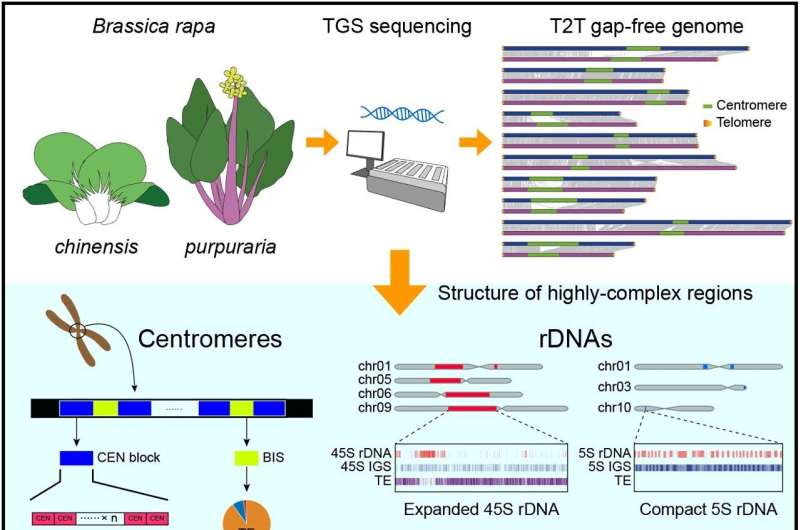This article has been reviewed according to Science X's editorial process and policies. Editors have highlighted the following attributes while ensuring the content's credibility:
fact-checked
trusted source
proofread
Mechanism of purple color and flavor of HongShanCaiTai, the imperial dish of China, revealed

Brassica has long been of paramount importance to agriculture and human nutrition, containing diverse popular crops such as kale, cauliflower, rapeseed, turnip, pak choi, cabbage, mustard, and choy sum, which are of high economic value worldwide. Till now, the genomes of more than 20 Brassica rapa crops have been assembled. However, fully complete genomes of B. rapa have yet to be assembled.
To fill the missing piece of the research and resolve the special agronomic traits of purpuraria, researchers utilized high-depth ONT and HiFi sequencing data to complete the first T2T gap-free genomes of B. rapa ssp. chinensis cv. AiJiaoBai, a leafy vegetable; and B. rapa ssp. purpuraria cv. HongShanCaiTai, a floral shoot vegetable. The research is published in the journal Science Bulletin.
Based on the gap-free genomes, the researchers resolved in detail the sequence features of the highly complex regions of B. rapa. The centromeres of B. rapa consisted of satellite sequences formed by 176-bp monomer. Unlike the typical tightly arranged structure rDNA in other plants, the 45S rDNA of B. rapa showed loose and significantly expanded characteristics, occupying large areas on the chromosomes. Insertion of a large number of specific types of TE is the main source of the expansion.
It is noteworthy that the 45S rDNA regions of B. rapa overlapped completely with its pericentromeres, indicating that the 45S rDNA may be related to the formation of pericentromeres somehow.
Purpuraria is purplish-red in color because of its high content of proanthocyanidins, a class of bioactive antioxidants that, prevents cardiovascular and cerebrovascular diseases, while possessing liver protection and other physiological functions.
By comparing the genomes of 21 B. rapa subspecies, the researchers found that a structural variant (SV) on chromosome 7 specific to the purpuraria ultimately led to the phenotype of its purple-red shoot stems. This SV is located in the promoter region, 245-bp upstream of the transcription factor BrMYB2 in a domestication locus of the purpuraria.
Subsequent experiments showed that the SV had resulted in significant up-regulation of BrMYB2 in the shoot stems of purpuraria, ultimately resulting in its purplish-red color. The presence of this SV and its effect was validated in several purpuraria accessions.
Purpuraria is favored for its unique flavor as a local seasonal specialty vegetable. Glucosinolates (GSLs) were previously reported to play a critical role in determining the special flavor of B. rapa. The researchers pointed out that several genes on aliphatic GSL biosynthesis pathway are significantly up-regulated in purpuraria leaves, suggesting that its biosynthesis in purpuraria may be significantly increased.
In addition, the GTR1 gene, which promotes the transport of GSLs from leaves to shoot stems, produced extra copies in purpuraria, which led to its tens of-fold up-regulation. The high biosynthesis of aliphatic GSLs and their efficient transport to the shoot stems may be the genetic basis for the special flavor of purpuraria as a floral shoot vegetable.
This study was led by Prof. Kun Wang (State Key Laboratory of Hybrid Rice of College of Life Sciences, Hubei Hongshan Laboratory of College of Life Sciences, Institute for Advanced Studies and RNA institute of Wuhan University), Prof. Aihua Wang (Wuhan Vegetable Research Institute, Wuhan Academy of Agricultural Sciences) and Prof. Qijun Nie (Institute of Economic Crops, Hubei Academy of Agricultural Sciences).
More information: Yifan Zhou et al, The complexity of structural variations in Brassica rapa revealed by assembly of two complete T2T genomes, Science Bulletin (2024). DOI: 10.1016/j.scib.2024.03.030
Provided by Science China Press




















